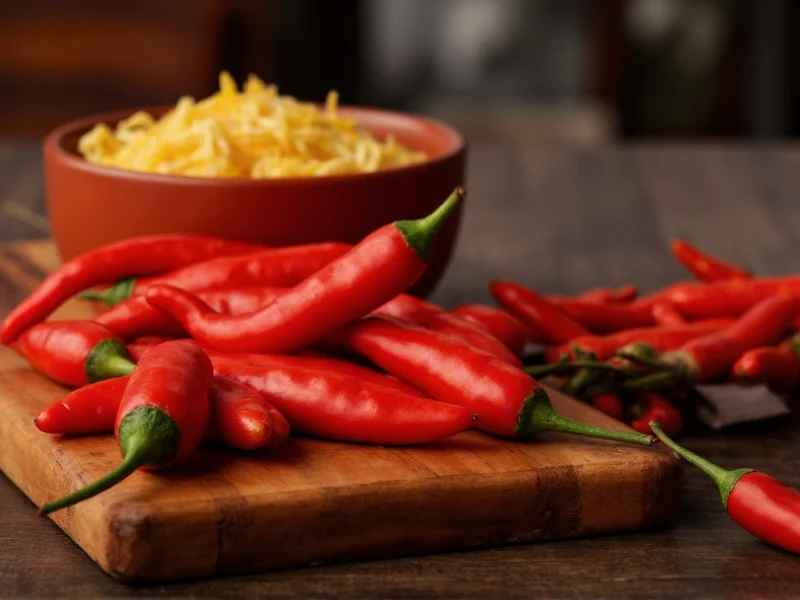Understanding how we measure the fiery intensity of chili peppers is essential for both culinary enthusiasts and food scientists. The Scoville scale remains the global standard for quantifying chili heat, though modern measurement techniques have evolved significantly from the original subjective testing method developed over a century ago.
The Evolution of Chili Heat Measurement
The story of chili heat measurement begins with Wilbur Scoville, a pharmacist who developed the Scoville Organoleptic Test in 1912. This original method involved human testers diluting chili extracts in sugar water until the heat became undetectable. The degree of dilution determined the Scoville rating—a 5,000 SHU pepper required dilution 5,000 times before the heat disappeared.
While groundbreaking for its time, the Scoville test had significant limitations. Human taste perception varies dramatically between individuals, and factors like palate fatigue affected consistency. Today, food laboratories have replaced this subjective approach with precise scientific instrumentation.
Modern Scientific Measurement: HPLC Analysis
High-Performance Liquid Chromatography (HPLC) has become the industry standard for accurate chili heat measurement. This sophisticated technique separates and quantifies the specific capsaicinoids present in chili peppers, including:
- Capsaicin (most prevalent)
- Dihydrocapsaicin
- Nordihydrocapsaicin
- Homocapsaicin
- Homodihydrocapsaicin
HPLC measures the exact concentration of these compounds in parts per million. The results are then mathematically converted to Scoville Heat Units using the formula: SHU = concentration of capsaicinoids (in ppm) × 16. The factor of 16 represents the approximate dilution factor from the original Scoville test.
Understanding the Scoville Heat Unit Scale
The Scoville scale provides a standardized measurement system that helps consumers understand pepper heat levels. Below is a comprehensive reference chart showing common peppers and their heat ranges:
| Pepper Variety | Scoville Heat Units (SHU) | Heat Level Description |
|---|---|---|
| Bell Pepper | 0 SHU | No heat |
| Jalapeño | 2,500–8,000 SHU | Moderate heat |
| Serrano | 10,000–23,000 SHU | Medium-hot |
| Cayenne | 30,000–50,000 SHU | Hot |
| Habanero | 100,000–350,000 SHU | Very hot |
| Ghost Pepper (Bhut Jolokia) | 800,000–1,041,427 SHU | Extremely hot |
| Carolina Reaper | 1,400,000–2,200,000 SHU | World's hottest (as of 2023) |
Practical Applications of Chili Heat Measurement
Accurate chili heat measurement serves multiple important purposes across various industries. Food manufacturers rely on precise SHU measurements to maintain consistent product quality in hot sauces, salsas, and spice blends. Understanding capsaicin content helps producers create products with predictable heat levels that match consumer expectations.
Chefs and home cooks benefit from knowing how to interpret Scoville ratings when selecting peppers for recipes. This knowledge prevents unpleasant surprises and helps balance flavors appropriately. When substituting one pepper for another, comparing their Scoville ratings provides a reliable guide to maintaining the intended heat profile.
The pharmaceutical industry also utilizes precise chili heat measurement. Capsaicin has medicinal applications in pain relief creams and patches, where controlled concentrations are critical for both effectiveness and safety.
Safety Considerations with High-Heat Peppers
Working with extremely hot peppers requires proper precautions. Capsaicin is oil-soluble and can cause severe irritation to skin and eyes. Always wear gloves when handling high-Scoville peppers like ghost peppers or Carolina reapers, and avoid touching your face during preparation.
If you experience capsaicin exposure, remember that water won't help—it spreads the oil. Instead, use dairy products (milk, yogurt), oils, or alcohol-based solutions to neutralize the burning sensation. Never use hand sanitizer on affected skin, as the alcohol can intensify the burning.
Common Misconceptions About Chili Heat Measurement
Several myths persist about measuring chili heat. Many believe that seed removal significantly reduces heat, but capsaicin primarily concentrates in the white pith (placenta) surrounding the seeds, not the seeds themselves. The color of a pepper doesn't reliably indicate heat level either—some red peppers are mild while some green varieties can be extremely hot.
Another misconception is that all measurement methods produce identical results. In reality, growing conditions, soil composition, and climate significantly affect a pepper's actual heat level, causing natural variation even within the same variety. This explains why two jalapeños from the same plant might register different Scoville ratings.
Alternative Measurement Systems
Besides the Scoville scale, the American Spice Trade Association (ASTA) uses a pungency measurement system based on colorimetry. While less consumer-friendly than Scoville units, ASTA measurements provide valuable data for industrial applications where precise capsaicin concentration matters more than consumer perception.
Some countries use their own localized measurement systems, but the Scoville scale remains the most widely recognized international standard for communicating chili heat to consumers. Food labeling regulations in many regions now require heat level indicators based on standardized measurement techniques.
Future of Chili Heat Measurement
Researchers continue developing more accessible heat measurement tools. Portable spectrometers and smartphone applications are emerging that could allow consumers to measure pepper heat at home with reasonable accuracy. These innovations may democratize chili heat measurement, making precise data available beyond professional laboratories.
As genetic research advances, scientists are also developing peppers with consistent heat levels through selective breeding, reducing the natural variation that complicates accurate measurement. This could lead to more reliable heat ratings for commercial pepper varieties in the future.











 浙公网安备
33010002000092号
浙公网安备
33010002000092号 浙B2-20120091-4
浙B2-20120091-4